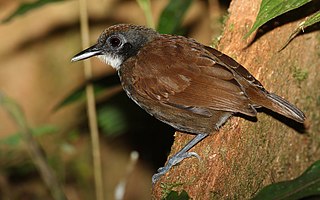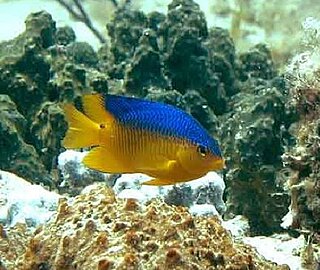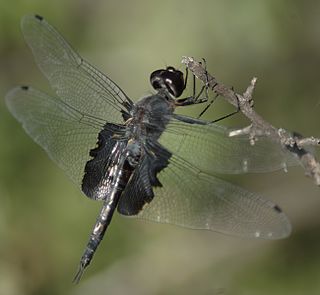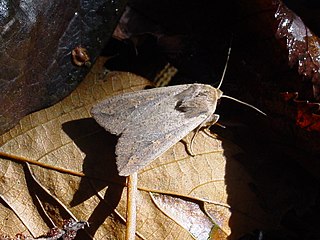
Flies are insects of the order Diptera, the name being derived from the Greek δι- di- "two", and πτερόν pteron "wing". Insects of this order use only a single pair of wings to fly, the hindwings having evolved into advanced mechanosensory organs known as halteres, which act as high-speed sensors of rotational movement and allow dipterans to perform advanced aerobatics. Diptera is a large order containing an estimated 1,000,000 species including horse-flies, crane flies, hoverflies, mosquitoes and others, although only about 125,000 species have been described.

The antbirds are a large passerine bird family, Thamnophilidae, found across subtropical and tropical Central and South America, from Mexico to Argentina. There are more than 230 species, known variously as antshrikes, antwrens, antvireos, fire-eyes, bare-eyes and bushbirds. They are related to the antthrushes and antpittas, the tapaculos, the gnateaters and the ovenbirds. Despite some species' common names, this family is not closely related to the wrens, vireos or shrikes.

Damselfish are those within the subfamilies Abudefdufinae, Chrominae, Lepidozyginae, Pomacentrinae, and Stegastinae within the family Pomacentridae. Most species within this group are relatively small, with the largest species being about 30cm in length. Most damselfish species exist only in marine environments, but a few inhabit brackish or fresh water. These fish are found globally in tropical, subtropical, and temperate waters.

Anopheles is a genus of mosquito first described by the German entomologist J. W. Meigen in 1818, and are known as nail mosquitoes and marsh mosquitoes. Many such mosquitoes are vectors of the parasite Plasmodium, a genus of protozoans that cause malaria in birds, reptiles, and mammals, including humans. The Anopheles gambiae mosquito is the best-known species of marsh mosquito that transmits the Plasmodium falciparum, which is a malarial parasite deadly to human beings; no other mosquito genus is a vector of human malaria.

Erythemis is a genus of dragonflies in the Libellulidae family, commonly known as pondhawks. These medium- to large-sized skimmers are voracious predators of other insects up to their own size, including other dragonflies.

Erythemis simplicicollis, the eastern pondhawk, also known as the common pondhawk, is a dragonfly of the family Libellulidae, native to the eastern two-thirds of the United States and southern Ontario and Quebec, Canada. It is a dragonfly of ponds and still waters. The species is distinguished in that the female is bright green with a banded abdomen and the mature male has a blue abdomen with a green face and green and blue thorax.

The black saddlebags is a species of skimmer dragonfly found throughout North America. It has distinctive wings with characteristic black blotches at their proximal ends, which make the dragonfly look as though it is wearing saddlebags.

Evarcha culicivora is a species of jumping spider found only around Lake Victoria in Kenya and Uganda. At maturity, E. culicivora spiders have an average size of 5 mm for both males and females. The range in size for either sex is quite small, with females being only slightly larger on average.

The Culicinae are the most extensive subfamily of mosquitoes (Culicidae) and have species in every continent except Antarctica, but are highly concentrated in tropical areas. Mosquitoes are best known as parasites to many vertebrate animals and vectors for disease. They are holometabolous insects, and most species lay their eggs in stagnant water, to benefit their aquatic larval stage.

Phrynomantis microps is an African frog with many interesting adaptations to the savannah. These frogs are also called the Accra snake-necked frog. They are found across Western and Central Africa. One of its distinguishing features is the peptide secretion on its skin, which goes beyond toxicity and seems to inhibit aggressive behavior like biting and stinging from large ants. This allows Phrynomantis microps to live in humid burrows within large ant nests and termite mounds, where they are frequently found. While Phrynomantis microps feeds on similar insects such as the termite Macrotermes bellicosus, they have never been found to feed on the ants they share the nest with. These frogs are medium-sized and have a bright red pelvic region.

Mosquito is a 1995 American science-fiction horror film directed by Gary Jones. The film features actor Gunnar Hansen, who portrayed the character Leatherface in the 1974 horror film The Texas Chain Saw Massacre, along with Ron Asheton, lead guitarist for the band the Stooges. The film has earned a cult following since its release.

Mythimna unipuncta, the true armyworm moth, white-speck moth, common armyworm, or rice armyworm, is a species of moth in the family Noctuidae. The species was first described by Adrian Hardy Haworth in 1809. Mythimna unipuncta occurs in most of North America south of the Arctic, as well as parts of South America, Europe, Africa, and Asia. Although thought to be Neotropical in origin, it has been introduced elsewhere, and is often regarded as an agricultural pest. They are known as armyworms because the caterpillars move in lines as a massive group, like an army, from field to field, damaging crops.

Culex pipiens is a species of mosquito commonly referred to as the common house mosquito or northern house mosquito, as it is the most common mosquito to the northern regions of the US. They can be found in both urban and suburban temperate and tropical regions across the world.

The guppy, also known as millionfish or the rainbow fish, is one of the world's most widely distributed tropical fish and one of the most popular freshwater aquarium fish species. It is a member of the family Poeciliidae and, like almost all American members of the family, is live-bearing. Guppies originate from northeast South America, but have been introduced to many environments and are now found all over the world. They are highly adaptable and thrive in many different environmental and ecological conditions. Male guppies, which are smaller than females, have ornamental caudal and dorsal fins. Wild guppies generally feed on a variety of food sources, including benthic algae and aquatic insect larvae. Guppies are used as a model organism in the fields of ecology, evolution, and behavioural studies.

Pantala hymenaea is a dragonfly of the family Libellulidae. It is a migratory species and is native to North, Central and South America, travelling widely and breeding in temporary water bodies. It looks very similar to the wandering glider, with the addition of a dark basal spot on the hindwing. It is a common species with a very large range and the International Union for Conservation of Nature has listed it as being of "least concern".

Anopheles freeborni, commonly known as the western malaria mosquito, is a species of mosquito in the family Culicidae. It is typically found in the western United States and Canada. Adults are brown to black, with yellow-brown hairs and gray-brown stripes on the thorax. Their scaly wings have four dark spots, which are less distinct in the male.

Rhamphomyia longicauda, the long-tailed dance fly, is a species of fly commonly found in eastern North America that belongs to the family Empididae and part of the superfamily of dance flies Empidoidea. It is included in the subgenus Rhamphomyia. This species of fly is most known for sex role reversal during courtship, as females put on exaggerated displays and congregate in leks to attract males. Females cannot hunt for food, so they receive protein from nuptial gifts brought to them by males. Female dependence on males for nutrition is the principal cause for sex role reversal in this species of fly.

Aedes taeniorhynchus, or the black salt marsh mosquito, is a mosquito in the family Culicidae. It is a carrier for encephalitic viruses including Venezuelan equine encephalitis and can transmit Dirofilaria immitis. It resides in the Americas and is known to bite mammals, reptiles, and birds. Like other mosquitoes, Ae. taeniorhynchus adults survive on a combination diet of blood and sugar, with females generally requiring a blood meal before laying eggs.
Chironomus annularius is a species of non-biting midge in the family Chironomidae. It is usually found in regions with bodies of fresh water but can be found in almost every environment. It tends to form "hotspots" around specific areas. The species is distinguished by the size of its chromosomes and the lack of a proboscis.

Tokunagayusurika akamusi is a midge fly species of the family Chironomidae, commonly called "nonbiting midges" or "lake flies."


















